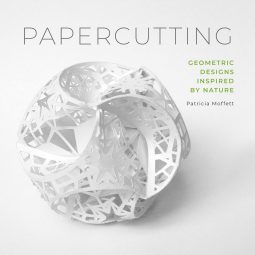 |
Papercutting
by Patricia Moffett ISBN-13: 9780764358081 Paperback: 128 pages Publisher: Schiffer Publishing Released: Sept. 28, 2019 |
Source: ebook review copy from the publisher through NetGalley.
Book Description, Modified from Goodreads:
These 25 projects show how ammonites, lichen rosettes, honeycomb, and other natural forms can help you apply the rules of mathematics to create complexly beautiful works. Clear, paper-art-focused explanations teach you the principles of mathematics we see in nature, including the Golden Section and Golden Angle, Fibonacci numbers, and symmetry. Learn about using flaps and piercings with various projects, including "A Murmuration of Starlings." Benefit from lessons in the Japanese art of kirigami and geometric principles, with projects such as "Kirigami Cascade" and "Rotational Symmetry." Tesselations and 2-D weaving, 3-D form assembly, woven 3-D forms, and stacked layers come into play for projects such as "Radiolarian" and "Sea Urchin." The role that display plays in your work is covered too, including flexagons in the "Undersea Frieze," black light in "UV Jelly Fish," and light-box effects in "Art Deco Scarab" and "Diatoms through the Microscope."
My Review:
Papercutting is a how-to instruction book on papercutting. The author did a great job of explaining different papercutting skills and techniques and building these skills with each new project. Each project had templates so you can copy what she's done, but she taught how to come up with ideas and use the techniques on your own. She clearly explained how to do each project, and even complete beginners should be able to follow the directions. She started with flat, cut-out projects, then she talked about weaving and explained different types of 3D projects. She even talked about how to display the finished projects, including lighting ideas and framing. Overall, I'd highly recommend this informative book to those interested in trying out papercutting.
If you've read this book, what do you think about it? I'd be honored if you wrote your own opinion of the book in the comments.









